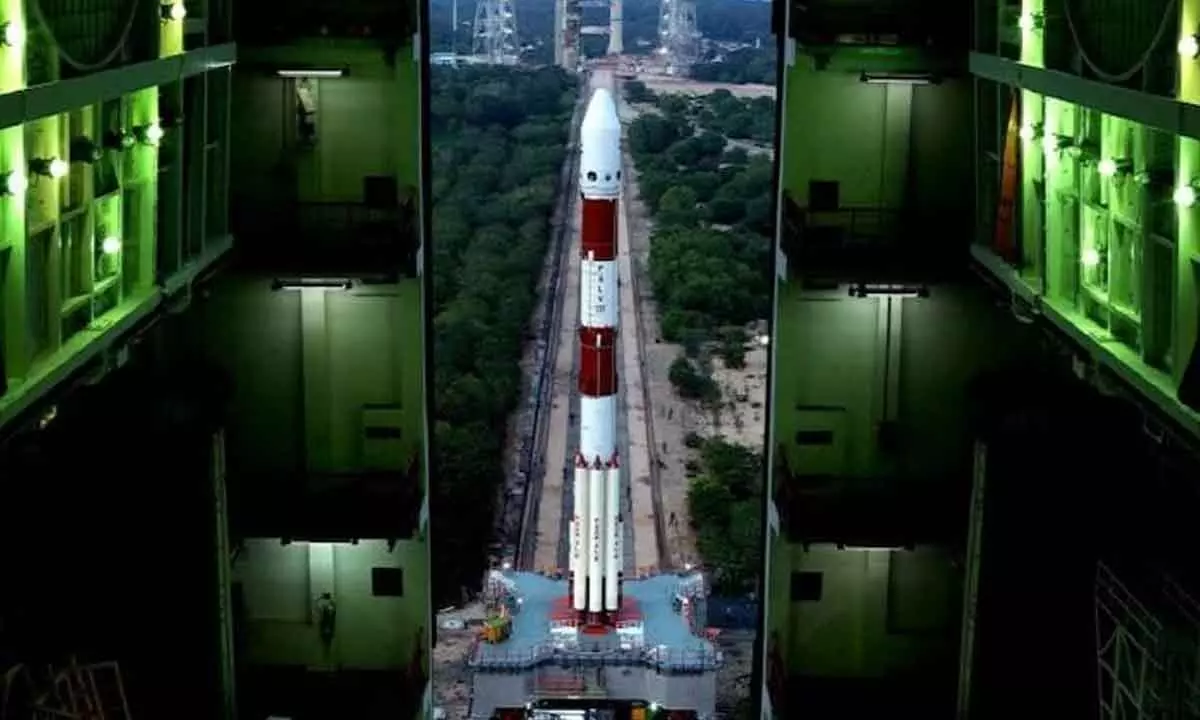Moon conquered, ISRO all set for Sun mission with Aditya launch on Sep 2

Days after landing on the Moon, India will aim for the Sun on Saturday with its maiden solar expedition, as ISRO's trusted PSLV will carry the Aditya L1 mission on a 125-day voyage to the Sun.
Sriharikota (AP) : Days after landing on the Moon, India will aim for the Sun on Saturday with its maiden solar expedition, as ISRO's trusted PSLV will carry the Aditya L1 mission on a 125-day voyage to the Sun. The 23.10 hour countdown for the launch of Aditya L1 onboard PSLV C57 commenced here on Friday, ISRO said.
The Sun observatory mission will be fired from the second launch pad at this spaceport at 11.50 am on Saturday, and comes close on the heels of India's successful moon expedition last month, Chandrayaan-3.
ISRO Chairman S Somanath said the Sun mission will take 125 days to reach the exact radius. Aditya L1 is designed for providing remote observations of the solar corona and conduct in-situ observations of the solar wind at L1 (Sun-Earth Lagrangian point), which is about 1.5 million kilometres from the Earth. According to ISRO, there are five Lagrangian points between the Sun and the Earth, and the L1 point in the Halo orbit would provide a greater advantage of continuously viewing the Sun without any occurrence of eclipse.
"This will provide a greater advantage of observing the solar activities continuously," ISRO said. On embarking on such a complex mission, the Bengaluru headquartered space agency said the Sun is the nearest star and therefore can be studied in much more detail as compared to the others. By studying the Sun much more about could be learnt aboyt stars in the Milky Way as well as in various other galaxies, ISRO said.
The Sun shows several eruptive phenomena and releases immense amounts of energy in the solar system. If such explosive solar phenomena are directed towards the earth, it could cause various types of disturbances in the near-earth space environment. Spacecraft and communication systems are prone to such disturbances; therefore, an early warning of such events is important for taking corrective measures beforehand, ISRO added.
ISRO scientists have used 'XL', the more powerful variant of the polar satellite launch vehicle (PSLV) that would carry the spacecraft on Saturday along with the seven payloads. Similar PSLV-XL variants were used in the Chandrayaan-1 mission in 2008 and the Mars Orbiter Mission (MOM) in 2013.
Of the total seven payloads, four onboard the spacecraft would directly view the Sun while the remaining three would undertake in-situ studies of particles and fields at the L1 point. Initially, the Aditya-L1 spacecraft would be placed in a low earth orbit. It would be made more elliptical and later the spacecraft will be launched towards the Lagrange point L1 by using on-board propulsion systems.
As the spacecraft travels towards L1, it will exit the Earth's gravitational Sphere of Influence. After exit, the cruise phase will start and subsequently, the spacecraft will be injected into a large halo orbit around L1. It would take nearly four months to reach the intended L1 point. The Aditya-L1 payloads are expected to provide the most crucial information to understand the problems of coronal heating, Coronal mass ejection (CME), pre-flare, and flare activities, and their characteristics, dynamics, and space weather.
The primary payload of Aditya-L1 the Visible Emission Line Coronagraph would be sending 1,440 images per day to the ground station for analysis on reaching the intended orbit. VELC, "the largest and technically most challenging" payload on Aditya-L1, was integrated, tested, and calibrated at the Indian Institute of Astrophysics CREST (Centre for Research and Education in Science Technology), campus in Hoskote near Bengaluru with substantial collaboration with ISRO.
"From the continuum channel, which is the imaging channel, an image will come -- one image per minute. So approximately 1,440 images for 24 hours, we will be receiving at the ground station," Aditya L1 Project Scientist and Operation Manager for VELC Dr Muthu Priyal said. As regards the propulsion systems in the mission, Thiruvananthapuram-based Liquid Propulsion System Centre (LPSC) has provided the required components. The Liquid Apogee Motor (LAM) developed by the LPSC has been crucial in satellite/spacecraft propulsion in India's major space achievements, be it the three Chandrayaan expeditions or the 2013 Mars Orbiter Mission (MOM).
"Now we also play a large role in the Aditya L1 Mission--the Aditya spacecraft. which has a very interesting, very versatile thruster called LAM, which is delivering a thrust of 440 newtons," Dr A K Asraff, deputy director of LPSC said. The objectives of the Mission include understanding the solar atmosphere, solar wind distribution, and temperature anisotropy, among others.
According to Indian Institute of Astrophysics (IIA) professor and in-charge scientist Dr R Ramesh, the monitoring of the Sun on a 24-hour basis is a must to study solar quakes which can alter the geomagnetic fields of the Earth. Explaining the need to study the Sun, he said that just as there are earthquakes on Earth, there are something called solar quakes -- called Coronal Mass Ejections (CME) on the surface of the Sun. In this process, millions and millions of tons of solar materials are thrown into the interplanetary space, and these CMEs can also be directed towards the Earth, he said














